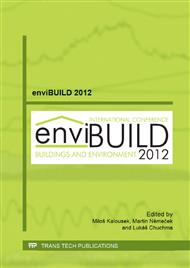p.97
p.101
p.105
p.109
p.113
p.117
p.121
p.125
p.129
Regeneration of Precast Panel Buildings in Terms of its Effect on Daylight
Abstract:
The regeneration of precast panel buildings is very often connected with a complete reconstruction of the existing external skin. This involves, in particular, the replacement of window openings, the installation of additional contact thermal insulation or modifications of projecting structures, including loggia glazing and, last but not least, changes in the colour shading of the surface façade layer. These interventions undoubtedly contribute to improved energy efficiency of the building, but secondary negative effects on the interior environment in terms of the daylight level must also be considered. As the aim is to modernise such buildings to reduce their energy, economic and ecological performance requirements, the maximum utilisation of daylight in the interior is one of non-negligible aspects.
Info:
Periodical:
Pages:
113-116
Citation:
Online since:
January 2013
Authors:
Price:
Сopyright:
© 2013 Trans Tech Publications Ltd. All Rights Reserved
Share:
Citation:


